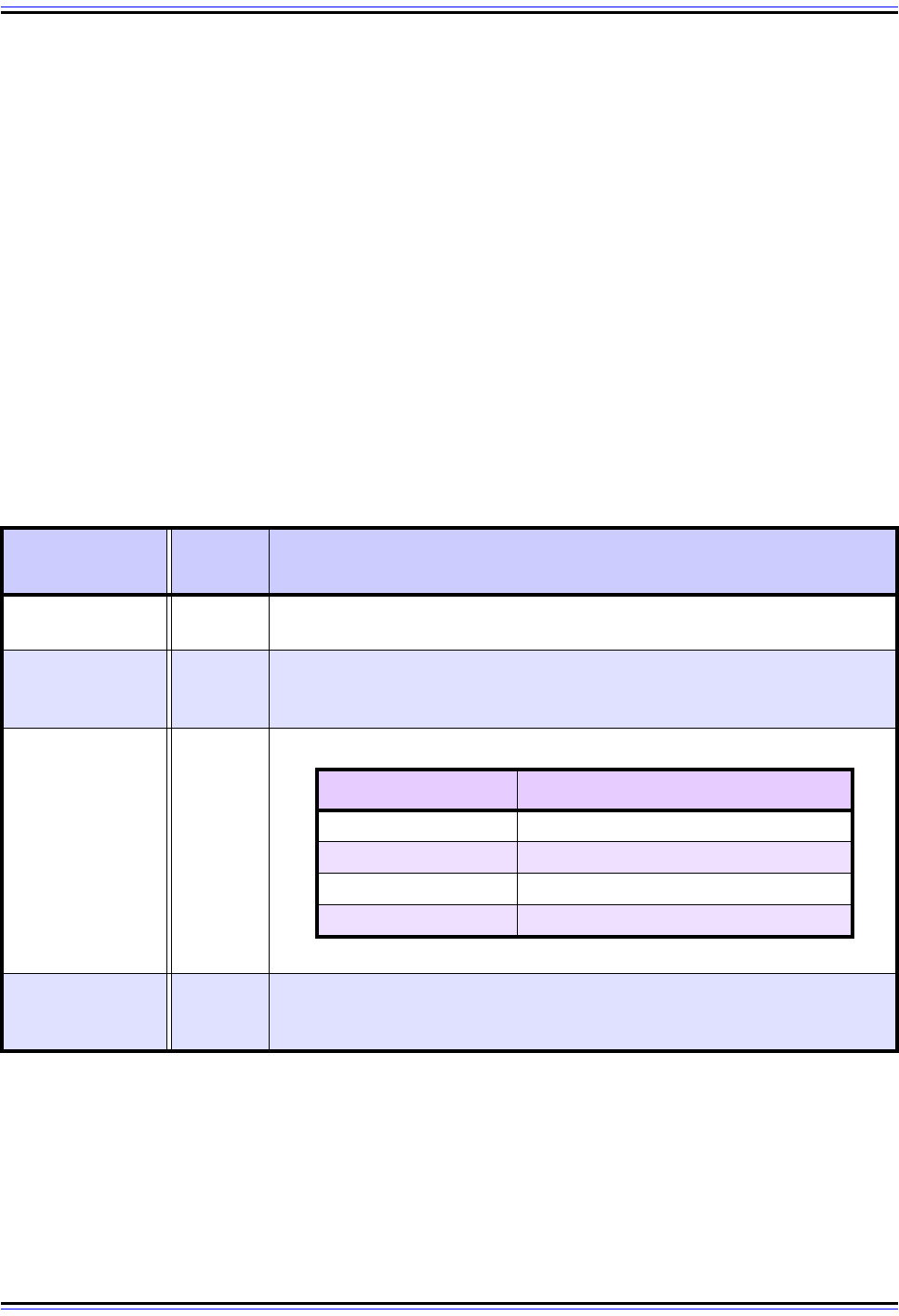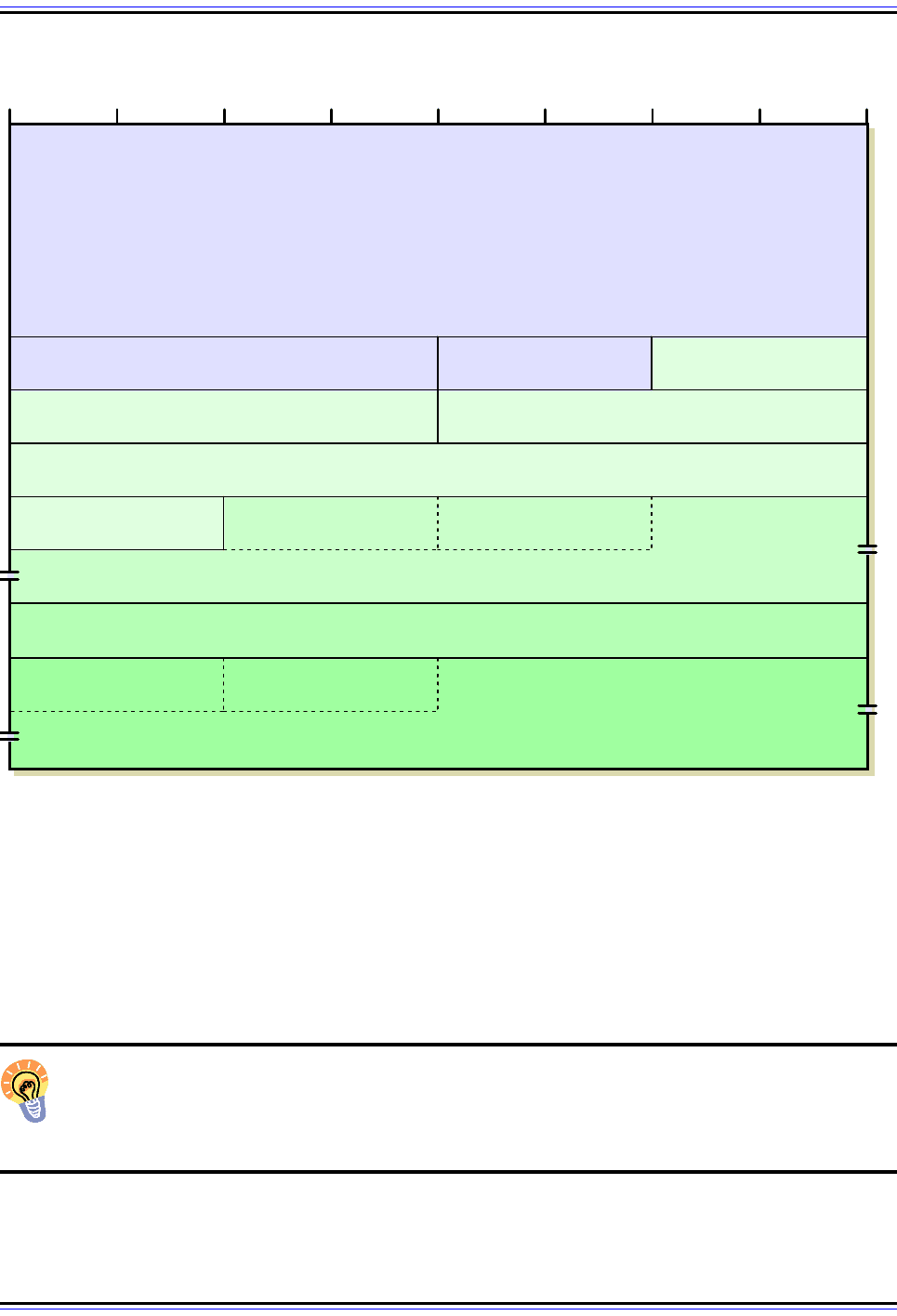Charles M. Kozierok The TCP-IP Guide
Подождите немного. Документ загружается.


The TCP/IP Guide - Version 3.0 (Contents) ` 781 _ © 2001-2005 Charles M. Kozierok. All Rights Reserved.
that database, and then choosing what routes to send from it to peer devices. In BGP, a
mechanism called the Decision Process is responsible for these tasks. It consists of three
overall phases:
1. Phase 1: Each route received from a BGP speaker in a neighboring AS is analyzed
and assigned a preference level. The routes are then ranked according to preference
and the best one for each network advertised to other BGP speakers within the auton-
omous system.
2. Phase 2: The best route for each destination is selected from the incoming data based
on preference levels, and used to update the local routing information base (the Loc-
RIB).
3. Phase 3: Routes in the Loc-RIB are selected to be sent to neighboring BGP speakers
in other ASes.
Criteria for Assigning Preferences to Routes
Obviously, if a BGP speaker only knows of a single route to a network, it will install and use
that route (assuming there are no problems with it). The assigning of preferences amongst
routes only becomes important when more than one route has been received by a BGP
speaker for a particular network. Preferences can be determined based on a number of
different criteria. Just a few typical ones include:
☯ The number of autonomous systems between the router and the network (fewer
generally being better).
☯ The existence of certain policies that may make certain routes unusable; for example,
a route may pass through an AS that this AS is not willing to trust with its data.
☯ The origin of the path—that is, where it came from.
In the case where a set of routes to the same network are all calculated to have the same
preference, a “tie-breaking” scheme is used to select from among them. Additional logic is
used to handle special circumstances, such as the case of overlapping networks (see the
description of the Atomic_Aggregate path attribute for an example of this).
The selection of routes for dissemination to other routers in Phase 3 is based on a rather
complex algorithm that I cannot do justice here. Route advertisement is guided by the
routing policies we discussed earlier in this section. Different rules are used to select routes
for advertising to internal peers compared to external peers.
Key Concept: The method used by a BGP speaker to determine what new routes to
accept from its peers and what routes to advertise back them is called the BGP
Decision Process. It is a complex algorithm in three phases that involves the compu-
tation of the best route based on both pre-existing and incoming path information.

The TCP/IP Guide - Version 3.0 (Contents) ` 782 _ © 2001-2005 Charles M. Kozierok. All Rights Reserved.
Limitations on BGP's Ability to Select Efficient Routes
When considering the route selection process, it's very important to remember that BGP is
a routing protocol that operates at the inter-autonomous-system level. Thus, routes are
chosen between ASes and not at the level of individual routers within an AS.So, for
example, when BGP stores information about the path to a network, it stores it as a
sequence of autonomous systems, not a sequence of specific routers. BGP cannot deal
with individual routers in an AS because by definition, the details of what happens within an
AS are supposed to be “hidden” from the outside world. It doesn't know the structure of
ASes outside its own.
However, this has an important implication for how BGP selects routes: BGP cannot
guarantee that it will pick the fastest, lowest-cost route to every network. It can select a
route that minimizes the number of ASes that lie between itself and a particular network, but
of course ASes are not all the same. Some ASes are large and consist of many slow links,
while others are small and fast. Choosing a route through two of the latter type of AS will be
better than choosing a route through one of the former, but BGP can't know that. Policies
can be used to influence AS selection to some extent, but in general, since BGP doesn't
know what happens in an AS, it cannot guarantee the efficiency of a route overall. (Inciden-
tally, this is the reason why there is no general “cost” or “distance” path attribute in BGP.)
Key Concept: As an exterior routing protocol, BGP operates at the autonomous
system level. Its routes are calculated based on paths between ASes, not individual
routers. Since BGP, by definition, does not know the internal structure of routers
within an AS, it cannot know for certain the cost to send a datagram across a given AS. This
in turn means that BGP cannot always guarantee that it will select the absolute lowest-cost
route between any two networks.
Originating New Routes and Withdrawing Unreachable Routes
Naturally, a facility exists to allow BGP speakers to originate new routes to networks. A
BGP speaker may obtain knowledge about a new route from an interior routing protocol on
an AS to which it is directly attached and choose to share this information with other ASes.
It will create a new entry in its RIB for this network and then send information about it out to
other BGP peers.
BGP also includes a mechanism for not only advertising routes it can reach, but those it
cannot. The latter are called unfeasible or withdrawn routes, and are mentioned in Update
messages as needed to indicate that a router can no longer reach the specific network.
BGP General Operation and Messaging
In the previous topics we have seen how BGP stores information about routes and uses it
to determine paths to various networks. Let's now take a high-level look at how BGP
operates in general terms. Like many other protocols covered in this Guide, BGP's

The TCP/IP Guide - Version 3.0 (Contents) ` 783 _ © 2001-2005 Charles M. Kozierok. All Rights Reserved.
operation can be described primarily in the form of messaging. The use of messages is the
means by which route information is communicated between BGP peers. This eventually
allows knowledge of how to reach networks to spread throughout the entire internetwork.
Speaker Designation and Connection Establishment
Before messaging can begin, BGP speakers must be designated, and then linked together.
The BGP standard does not specify how neighboring speakers are determined; this must
be done outside the protocol. Once accomplished, ASes are connected into a BGP-enabled
internetwork. Topological linking provides the physical connection and the means for
datagrams to flow between ASes. At this point the dance floor is prepared, but nobody is
dancing; BGP can function but isn't yet in operation.
BGP operation begins with BGP peers forming a transport protocol connection. BGP uses
TCP for its reliable transport layer, so the two BGP speakers establish a TCP session that
remains in place during the course of the subsequent message exchange. When this is
done, each BGP speaker sends a BGP Open message. This message is like an “invitation
to dance”, and begins the process of setting up the BGP link between the devices. In this
message, each router identifies itself and its autonomous system, and also tells its peer
what parameters it would like to use for the link. This includes an exchange of authenti-
cation parameters. Assuming that each device finds the contents of its peer's Open
message acceptable, it acknowledges it with a Keepalive message and the BGP session
begins.
Under normal circumstances, most BGP speakers will maintain simultaneous sessions with
more than one other BGP speaker, both within its own AS and outside the AS. Links
between ASes are of course what enable BGP routers to learn how to route through the
internetwork. Links within the AS are important to ensure that each BGP speaker in the AS
maintains consistent information.
Route Information Exchange
Assuming the link is initialized, the two peers begin an ongoing process of telling each other
what they know about networks and how to reach them. Each BGP speaker encodes infor-
mation from its Routing Information Bases (RIBs) into BGP Update messages. These
messages contain lists of known network addresses, as well as information about paths to
various networks, described in the form of path attributes. This information is then used for
the route determination as described in the preceding topic.
When a link is first set up between two peers, they ensure complete information is held by
each router by exchanging their complete routing tables. Subsequently, Update messages
are sent that contain only incremental updates about routes that have changed. Exchanging
only updated information as needed reduces unnecessary bandwidth on the network,
making BGP more efficient than it would be if it sent full routing table information on a
regular basis.

The TCP/IP Guide - Version 3.0 (Contents) ` 784 _ © 2001-2005 Charles M. Kozierok. All Rights Reserved.
Connectivity Maintenance
The TCP session between BGP speakers can be kept open for a very long time, but
Updates need to be sent only when changes occur to routes, which are usually infrequent.
This means many seconds may elapse between the transmission of Update messages. To
ensure that the peers maintain contact with each other, they both send Keepalive
messages on a regular basis when they don’t have other information to send. These are
null messages that contain no data and just tell the peer device “I'm still here”. These
messages are sent infrequently—no more often than one per second—but regularly
enough that the peers won't think the session was interrupted.
Error Reporting
The last type of BGP message is the BGP Notification message. This is an error message;
it tells a peer that a problem occurred and describes the nature of the error condition. After
sending a BGP Notification message, the device that sent it will terminate the BGP
connection between the peers. A new connection will then need to be negotiated, possibly
after the problem that led to the Notification has been corrected.
Key Concept: BGP is implemented through the exchange of four different message
types between BGP speakers. A BGP session begins with a TCP connection being
established between two routers and each sending an Open message to the other.
BGP Update messages are the primary mechanism by which routing information is
exchanged between devices. Small BGP Keepalive messages are used to maintain
communication between devices between periods that they need to exchange information.
Finally, Notification messages are used for problem reporting.
For more details on the four BGP message types and a description of the format used by
each, refer to the detailed BGP operation section.

The TCP/IP Guide - Version 3.0 (Contents) ` 785 _ © 2001-2005 Charles M. Kozierok. All Rights Reserved.
BGP Detailed Messaging, Operation and Message Formats
The previous section described the concepts and general operation of the Border Gateway
Protocol (BGP). To get a better understanding of exactly how BGP works, it is helpful to
take a deeper look at its four different message types and how they are used. As we do this,
we can examine the fields in each message type, to help us comprehend not just the way
that messaging is accomplished, but the way that routing data is actually communicated.
In this section I provide a comprehensive description of the communication that takes place
between BGP speakers by providing details on BGP message types, how they are used,
and the data elements they contain. I begin with a description of common attributes of BGP
message generation and transport, and the general format used for all BGP messages. I
then provide a detailed description of each of the four BGP message types: Open, Update,
Keepalive and Notification messages.
Background Information: If you have not yet already done so, you should read
the high-level description of general BGP operation and messaging, which shows
how these messages fit together.
BGP Message Generation and Transport, and General Message Format
Each router running BGP generates messages to implement the various functions of the
protocol. Some of these messages are created on a regular basis by the BGP software
during the course of its normal operation. These are generally controlled by timers that are
set and count down to cause them to be sent. Other messages are sent in response to
messages received from BGP peers, possibly after a processing step.
BGP Message Transport
BGP is different from most other routing protocols in that it was designed from the start to
operate using a reliable method of message delivery. The Transmission Control Protocol
(TCP) is present in the software of every IP router, making it the obvious choice for reliable
data communication in a TCP/IP internet, and that's what BGP uses. Routing protocols are
usually considered part of layer three, but this one runs over a layer four protocol, making
BGP a good example of why architectural models are best used only as a guideline.
TCP provides numerous advantages to BGP by taking care of most of the details of session
setup and management, allowing BGP to focus on the data it needs to send. TCP takes
care of session setup and negotiation, ensuring that messages are received and acknowl-
edged, flow control, congestion-handling and any necessary retransmissions of lost
messages. BGP uses well-known TCP port 179 for connections.

The TCP/IP Guide - Version 3.0 (Contents) ` 786 _ © 2001-2005 Charles M. Kozierok. All Rights Reserved.
BGP General Message Format
The use of TCP also has an interesting impact on the way BGP messages are structured.
One thing that stands out when you look at the BGP message format (as we will see
shortly) is that a BGP message can have an odd number of bytes. Most routing protocols
are sized in units of 4 or 8 bytes, but since TCP sends data as a stream of octets there is no
need for BGP messages to break on a 32-bit or 64-bit boundary. The other impact is the
need of a special Marker field to help ensure that BGP messages can be differentiated from
each other in the TCP stream (more about this in a moment).
Like most messaging protocols, BGP uses a common message format for each of its four
message types. Each BGP message is conceptually divided into a header and a body
(called the data portion in the BGP standard). The header has three fields and is fixed in
length at 19 bytes. The body is variable in length, and in fact is omitted entirely in Keepalive
messages, since it is not needed for them.
The general format for all BGP message types is shown in Table 137 and Figure 192.
The Marker Field, Message Synchronization and Authentication
The Marker field is the most interesting one in the BGP message format, and as mentioned
in the table is used for both synchronization and authentication. BGP uses a single TCP
session to send many messages in a row. TCP is a stream-oriented transport protocol
Table 137: BGP General Message Format
Field Name
Size
(bytes)
Description
Marker 16
Marker: This large field at the start of each BGP message is used for
synchronization and authentication.
Length 2
Length: The total length of the message in bytes, including the fields of the
header. The minimum value of this field is 19 for a Keepalive message; it
may be as high as 4,096.
Type 1
Message Body /
Data Portion
Variable
Message Body / Data Portion: Contains the specific fields used to
implement each message type, for Open, Update and Notification
messages.
Type: Indicates the BGP message type:
Type Value (Decimal) Message Type
1 Open
2 Update
3 Notification
4 Keepalive

The TCP/IP Guide - Version 3.0 (Contents) ` 787 _ © 2001-2005 Charles M. Kozierok. All Rights Reserved.
which just sends bytes across the link without any knowledge of what the bytes represent.
This means that the protocol using TCP is responsible for deciding where the line is drawn
between data units, in this case BGP messages.
Normally, the Length field tells each BGP device where to draw the line between the end of
one message and the start of the next. However, it is possible that due to various conditions
a device might lose track of where the message boundary is. The Marker field is filled with a
recognizable pattern that clearly marks the start of each message, to keep BGP peers
synchronized.
Before a BGP connection is established, the Marker field is just filled with all ones. Thus,
this is the pattern used for Open messages. Once a BGP session is negotiated, if
agreement is reached on an authentication method between the two devices, the Marker
field takes on the additional role of authentication. Instead of looking for a Marker containing
all ones, BGP devices look for a pattern generated using the agreed-upon authentication
method. Detection of this pattern simultaneously synchronizes the devices and ensures that
messages are authentic.
In extreme cases, BGP peers may be unable to maintain synchronization, and if so, a Notifi-
cation message is generated and the session is closed. This will also happen if the Marker
field contains the wrong data when authentication is enabled.
Figure 192: BGP General Message Format
Marker
(128 bits)
Length Type
Message Body
4 8 12 16 20 24 28 320

The TCP/IP Guide - Version 3.0 (Contents) ` 788 _ © 2001-2005 Charles M. Kozierok. All Rights Reserved.
Key Concept: All four BGP message types use a general message format that
contains three fixed header fields—Marker, Length and Type—and room for a
message body that differs for each message type. The large Marker field is used to
denote the start of a new BGP message, and is also used to facilitate the BGP authenti-
cation method.
BGP Connection Establishment: Open Messages
Before a BGP session can be used to exchange routing information, a connection must first
be established between BGP peers. This process begins with the creation of a TCP
connection between the devices. Once this is done, the BGP devices will attempt to create
a BGP session by exchanging BGP Open messages.
The Open message has two main purposes. The first is identification and initiation of a link
between the two devices; it allows one peer to tell the other “I am a BGP speaker named X
on autonomous system Y, and I want to start exchanging BGP information with you”. The
second is negotiation of session parameters. These are the terms by which the BGP
session will be conducted. One important parameter negotiated using Open messages is
the method that each device wants to use for authentication. The importance of BGP
means that authentication is essential, to avoid bad information or a malicious person from
disrupting routes.
Each BGP receiving an Open message processes it. If its contents are acceptable,
including the parameters the other device wants to use, it responds with a Keepalive
message as an acknowledgment. Each peer must send an Open and receive a Keepalive
acknowledgment for the BGP link to be initialized. If either is not willing to accept the terms
of the Open, the link is not established. In that case, a Notification message may be sent to
convey the nature of the problem.
BGP Open Message Format
The specific format for BGP Open messages can be found in Table 138 and Figure 193.
Table 138: BGP Open Message Format (Page 1 of 2)
Field Name
Size
(bytes)
Description
Marker 16
Marker: This large field at the start of each BGP message is used for
synchronization and authentication. See the discussion of the BGP general
message format for details.
Length 2
Length: The total length of the message in bytes, including the fields of the
header. Open messages are variable in length.
Type 1 Type: BGP message type, value is 1 for Open messages.

The TCP/IP Guide - Version 3.0 (Contents) ` 789 _ © 2001-2005 Charles M. Kozierok. All Rights Reserved.
Version 1
Version: Indicates the BGP version the sender of the Open message is
using. This field allows devices to reject connections with devices using
versions they may not be capable of understanding. The current value is 4,
for BGP-4, and is used by most, if not all, current BGP implementations.
My Autonomous
System
2
My Autonomous System: Identifies the autonomous system number of
the sender of the Open message. AS numbers are centrally managed
across the Internet in a manner similar to how IP addresses are
administered.
Hold Time 2
Hold Time: The number of seconds that this device proposes to use for
the BGP hold timer, which specifies how long a BGP peer will allow the
connection to be left silent between receipt of BGP messages. A BGP
device may refuse a connection if it doesn't like the value that its peer is
suggesting; usually, however, the two devices agree to use the smaller of
the values suggested by each device.
The value must be at least 3 seconds, or 0. If 0, this specifies that the hold
timer is not used. See the Keepalive message discussion for more on how
the hold timer is used.
BGP Identifier 4
BGP Identifier: Identifies the specific BGP speaker. Recall that IP
addresses are associated with interfaces, not devices, so each router will
have at least two IP addresses. Normally the BGP identifier is chosen as
one of these addresses. Once chosen, this identifier is used for all BGP
communications with BGP peers. This includes BGP peers on the interface
from which the identifier was chosen, and also BGP peers on other inter-
faces as well. So, if a BGP speaker with two interfaces has addresses IP1
and IP2, it will choose one as its identifier and use it on both of its
interfaces.
Opt Parm Len 1
Optional Parameters Length: The number of bytes used for Optional
Parameters (see below). If 0, no optional parameters are in this message.
Optional
Parameters
Variable
Table 138: BGP Open Message Format (Page 2 of 2)
Field Name
Size
(bytes)
Description
O
p
ti
ona
l
P
arame
t
ers:
All
ows
th
e
O
pen message
t
o commun
i
ca
t
e any
number of extra parameters during BGP session setup. Each parameter is
encoded using a rather standard “type / length / value” triple, as follows:
Subfield
Name
Size
(bytes)
Description
Parm Type 1
Parameter Type: The type of optional parameter.
At present, only one value is defined, 1, for
authentication Information.
Parm Length 1
Parameter Length: Specifies the length of the
Parameter Value subfield (thus, this value is the
length of the entire parameter less 2).
Parm Value Variable
Parameter Value: The value of the parameter
being communicated.

The TCP/IP Guide - Version 3.0 (Contents) ` 790 _ © 2001-2005 Charles M. Kozierok. All Rights Reserved.
BGP Open messages currently use only one optional parameter: Authentication Infor-
mation. Its Parameter Value subfield contains a one-byte Authentication Code sub-subfield,
which specifies the type of authentication a device wishes to use. Following this is a
variable-length Authentication Data sub-subfield. The Authentication Code specifies how
authentication is to be performed, including the meaning of the Authentication Data field,
and the manner in which Marker fields are to be calculated.
Key Concept: BGP sessions begin with each peer in a connection sending the other
a BGP Open message. The purpose of this message is to establish contact between
devices, identify the sender of the message and its autonomous system, and
negotiate important parameters that dictate how the session will be conducted.
Figure 193: BGP Open Message Format
Marker
(128 bits)
Length Type = 1 Version
My Autonomous System Hold T ime
BGP Identifier
Optional Parameters
Length
Parameter Type #1 Parameter Length #1
Parameter Value #1
Parameter Type #N Parameter Length #N
Parameter Value #N
4 8 12 16 20 24 28 320
...
